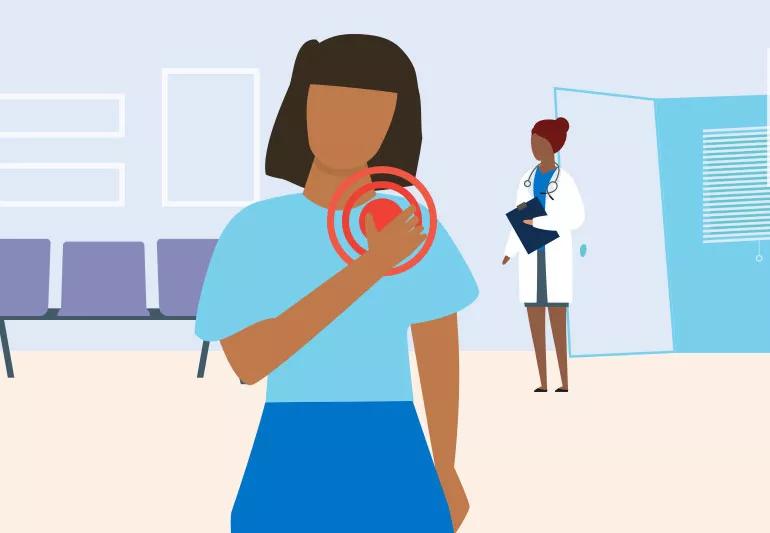It could be an injury, arthritis, a bone infection or even the position of your collarbone

Like a beam spanning two tall posts, your collarbone connects your breastbone (sternum) and shoulder. We actually have two collarbones — one attached to each of your shoulders. Your collarbones frame your chest and help support your neck and arms.
Advertisement
Cleveland Clinic is a non-profit academic medical center. Advertising on our site helps support our mission. We do not endorse non-Cleveland Clinic products or services. Policy
But these long, thin bones can be a source of pain, says orthopaedic surgeon Jason Ho, MD. That pain can be sharp and severe or a dull ache. It may hurt when you move or even breathe.
Your collarbone, or clavicle, is slightly s-shaped with joints at either end. Ligaments attach the surrounding muscles to the bone at each joint to hold it in place. The two collarbone joints are:
Your collarbone may hurt because of an issue with your bone or its joints. Or the pain could be due to injury or disease.
The most common causes of collarbone pain are injuries and arthritis. Less often, you may have a bone infection or a narrowed space between your collarbone and the underlying rib. If you have sudden collarbone pain after a fall or other trauma, get emergency medical care.
Dr. Ho says these are the main causes of collarbone pain:
Fractured (broken) collarbones are among the most common bone fractures. They affect about 1 in 1,000 people each year and make up about 10% of all bone breaks.
Advertisement
Most of the time, a collarbone fracture happens when you fall directly on your shoulder or an extended hand. How this happens can vary with age:
Healthcare providers classify collarbone fractures based on where they occur and their severity. About 70% of clavicle fractures occur in the middle section of the bone. This section is the thinnest and doesn’t have any muscles and ligaments to support it. Less often, the fracture occurs near the shoulder end. Rarely, breaks can happen at the end of the collarbone nearest your breastbone.
Pain is the main symptom of a collarbone fracture. You might see the fracture under your skin, or the bone may stick out. Depending on the severity of the break, you may also experience:
Dr. Ho says some clavicle fractures may require surgery. Most of the time, they can be treated by wearing a sling and gradually increasing your range of motion and strength through physical therapy.
A fall or other trauma may cause one of your collarbone joints to separate. This can happen at the shoulder (acromioclavicular joint) or breastbone (sternoclavicular joint). The symptoms of joint separation are similar to fracture symptoms — pain, swelling and limited movement.
“Treatments like medication, immobilization, steroid injections and physical therapy usually relieve pain and help you move better so you can be fully active,” Dr. Ho shares. We typically consider surgery if other treatments don’t help or for severe joint displacement.”
Arthritis is the breakdown of cartilage — the tissue that cushions your joints and prevents bones from rubbing together. Osteoarthritis is the most common type of arthritis that occurs due to wear-and-tear on your joints.
You can get osteoarthritis in one or more of your collarbone joints. The main symptoms are pain, stiffness and swelling. Lifting heavy weights can also wear away the end of your collarbone where it meets your shoulder, causing arthritis.
You can’t cure osteoarthritis, but treatment like over-the-counter pain relievers and steroid injections can improve symptoms.
Rarely, Dr. Ho says healthcare providers use surgery to treat arthritis in the acromioclavicular joint. But for sternoclavicular joint arthritis, he advises against surgery. “Large blood vessels run just behind the clavicle, making this surgery risky,” he explains. “It’s typically a last resort when other treatments are unsuccessful.”
Advertisement
A bone infection (osteomyelitis) occurs when bacteria or fungi infect a bone. Bone infections are rare in healthy people. They typically occur due to:
If you have an infection in your collarbone, you may have pain, swelling and other symptoms, such as fever or chills. Factors that increase your risk of osteomyelitis include:
Osteomyelitis can cause bone damage, so quick treatment is essential. You’ll likely receive IV antibiotics in the hospital. Your provider may also recommend surgery to clean out the infected area or remove damaged bone tissue.
Your thoracic outlet is the area between your collarbone and underlying rib. Nerves and blood vessels pass through this narrow space as they travel to your shoulder and arm.
In thoracic outlet syndrome, the space between your collarbone and rib tightens. This narrowing can be a result of:
Advertisement
Thoracic outlet syndrome can cause a wide range of symptoms in your shoulder, arm or hand. Symptoms often come and go with certain positions, especially when you raise your arm over your head. In addition to collarbone pain, you may have:
“Because the symptoms are so broad, it’s challenging to diagnose thoracic outlet syndrome,” Dr. Ho notes. “You may see several providers before getting an accurate diagnosis. If you can replicate, or reproduce, your symptoms when you move into certain positions, ask your provider if thoracic outlet syndrome could be the cause.”
Physical therapy is a highly effective treatment for thoracic outlet syndrome. Surgery is usually only an option for severe symptoms.
Most bone cancers spread from cancer in another part of your body (metastatic). Primary bone cancer starting in the bone affects fewer than 4,000 people in the U.S. each year.
“The collarbone is a rare site for bone cancer,” Dr. Ho clarifies. “But if you have a history of cancer, talk to your provider if you have any bone pain or lumps.”
Advertisement
If you have collarbone pain following a fall or other trauma, go to an emergency room. You’ll need a thorough exam and X-rays to determine if your collarbone is fractured.
For less severe symptoms, Dr. Ho recommends rest, ice and over-the-counter anti-inflammatory medications (either the kind you take by mouth or topical ointments). If you don’t notice any improvement for a week or if symptoms get worse, see a healthcare provider and get checked out.
Ongoing pain, swelling, lumps or problems moving are signs that something isn’t right. A visit to a provider can help you find the cause and get started with treatment.
Learn more about our editorial process.
Advertisement

Plus, ways to keep your bones healthy and strong!

Bone health starts with proper nutrition, exercise and healthy lifestyle choices

Why pills aren't a substitute for food

Looking down at your smartphone or computer screen can stress muscles in your neck, shoulders and back

While an ultrasound shows your muscles and tendons, an MRI also shows your joint cartilage, bones and heart chambers

Rest, physical therapy, pain relief medication and steroid injections may be able to help instead

Getting enough of this essential mineral is important for your bones, teeth and so much more

Tendinopathy tends to get better with rest, ice, pain management and physical therapy

Start having sex about 72 hours before ovulation, then at least every other day during your fertile window

Attachment theory suggests that your earliest relationships shape connections throughout your life

It isn’t a recognized mental health disorder, but research shows that problematic social media use can negatively affect your mental health, self-esteem and sleep